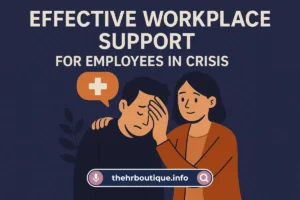I’ll never forget the look on Mr. Tanaka’s face when I handed him my business card.
Fresh out of HR training, I was so proud of myself for remembering to bring my business cards to our meeting with the Japanese client. What I didn’t know was that you’re supposed to present them with both hands, carefully study the one you receive, and never—ever—just toss it into your bag like a grocery receipt.
The subtle tightening of his smile told me everything. I’d already messed up, and the meeting hadn’t even started.
This is the reality of HR in a global workforce. That perfectly reasonable policy? Might be offensive in Mumbai. That standard interview question? Could be illegal in Berlin. That casual feedback style your team loves? Might make your Vietnamese employee quit on the spot.
Why This Isn’t Just About Being “Politically Correct”?
A few years back, we lost one of our best Indian developers because his American manager kept praising him publicly in team meetings. Sounds harmless, right? Not in his culture—where being singled out felt like he was being set up for resentment.
These aren’t just awkward moments. They’re expensive mistakes:
- Misunderstood feedback = Disengaged employees.
- Cultural blind spots = Lost clients.
- Tone-deaf policies = High turnover.
And here’s the kicker—most of these disasters could’ve been avoided with a few simple adjustments.
3 Cultural Missteps You’re Probably Making Right Now
1. The Feedback Fiasco
Early in my career, I gave “constructive criticism” to a Finnish employee in front of his peers. Big mistake. What I thought was helpful, he saw as humiliating. In Finland:
- Feedback is private.
- Silence = careful consideration, not disengagement.
- Directness is appreciated, but not public critique.
What works better:
- For direct cultures (Germany, Israel): “Here’s what’s not working—let’s fix it.”
- For indirect cultures (Japan, Thailand): “I noticed some opportunities here…”
- For hierarchical cultures (India, South Korea): Have senior leaders deliver tough messages.
2. The Meeting Time Warp
I once scheduled a “quick 15-minute check-in” with our Brazilian team. They arrived with coffee and settled in for a chat. Turns out:
- Americans: Meetings are transactional.
- Latin cultures: Meetings are for relationship-building.
- Nordic countries: Get to the point—no small talk.
Pro tip: Always clarify: “This will be a [brief update / working session]. Does that work for everyone?”
3. The Email That Bombed
My biggest email fails:
- Sent a two-line “efficient” update to our Indian partners (they saw it as rude).
- Used first names with German executives (they prefer titles).
- Included a thumbs-up emoji for a Middle Eastern client (apparently, it’s like flipping someone off).
Now I keep a cheat sheet:
- Germany: Formal, straight to the point.
- India: Start with personal greetings.
- Brazil: Friendly tone, relationship-first.
How We Fixed Our HR Team’s Cultural IQ (Without Boring Everyone to Tears)?
1. The “Culture Swap” Lunch
Once a month, team members share:
- One thing about work culture in their country that surprises Americans.
- One American work habit they find bizarre.
- Our French colleagues still can’t believe we eat lunch at our desks.
2. The “Oops Jar”
Every cultural blunder costs $5 (goes toward team snacks). My Japanese business card disaster? First contribution. It:
- Makes learning fun.
- Normalizes mistakes.
- Funds our monthly international potluck.
3. The 5-Minute Rule
Before any cross-cultural interaction, we ask:
- How does this culture view time/deadlines?
- What’s their communication style?
- Any hierarchy norms?
- Major taboos to avoid?
- What’s their meeting culture like?
The One Question That Solves 90% of Problems
After years of trial and error, here’s my golden rule: When in doubt, just ask.
Instead of assuming:
- “How would you like to receive feedback?”
- “What’s the best way to communicate updates to your team?”
- “Are there any cultural norms we should be aware of?”
Most people appreciate the effort—even if you don’t get it perfect.
Try This Today
Pick one small change:
- Ask a colleague about a work norm from their culture.
- Review your templates for hidden assumptions.
- Share a cultural blunder story with your team.
Because here’s the truth: You don’t need to be an expert on every culture—you just need to be aware that differences exist, and be willing to adapt.
What’s your most cringe-worthy cross-cultural work moment? (Mine’s definitely the business card incident.) Share yours below—let’s learn from each other’s mistakes!





